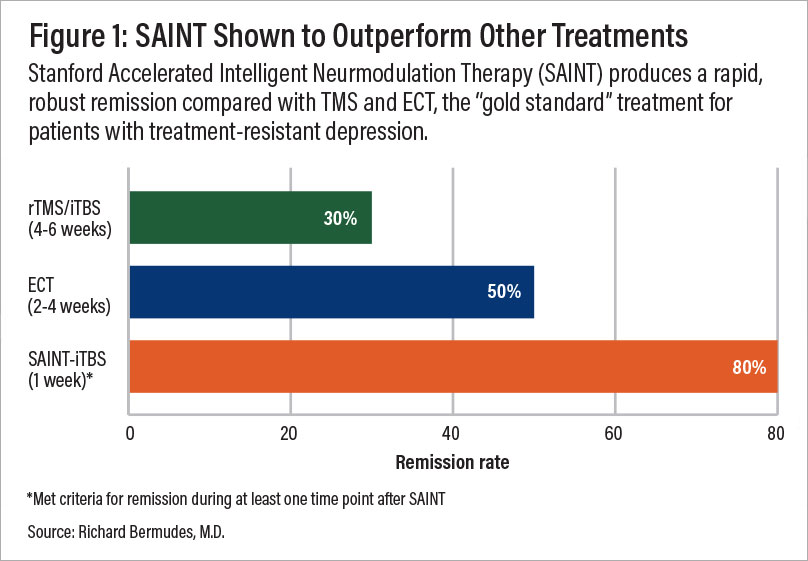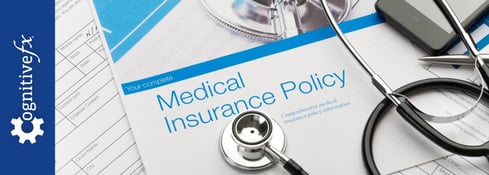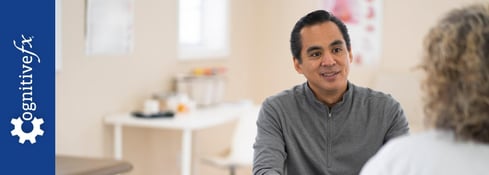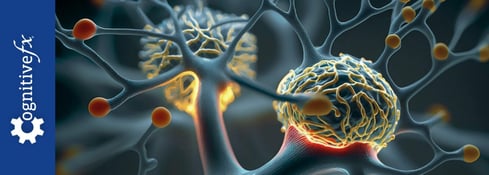If you’re considering Transcranial Magnetic Stimulation (TMS) — a procedure that uses electromagnetic pulses to improve depression symptoms — you may be wondering what the treatment actually feels like.
The good news: TMS treatment is generally painless and involves minimal side effects for the vast majority of patients. You typically feel a light tapping sensation on your scalp where the magnetic pulses are delivered. This may cause temporary scalp discomfort, but usually improves after the first session or two as patients adjust to the treatment process.
In this article, we’ll cover:
What Happens During a TMS Session?
Depending on the type of medical devices used, TMS sessions last anywhere from a few minutes to about 40 minutes. It’s a non-invasive treatment that doesn’t require anesthesia or a long recovery time.
Here’s what happens:
-
Sit comfortably: You’ll sit in a reclining chair and remain awake and alert. Many patients read, listen to music, or relax during their course of treatment.
-
Remove metal items: Glasses and jewelry are removed for safety.
-
Hearing protection: You’ll wear earplugs since the magnetic coil makes loud clicking noises.
-
Coil placement: A small TMS coil is positioned on your scalp to stimulate the prefrontal cortex, an area of the brain that plays a role in mood regulation. Depending on the device, the coil may look like a helmet or an arm attachment.
What Does TMS Feel Like During the Session?
Patients undergoing TMS therapy often describe these sensations:
-
Mild tapping or pulsing: Feels like someone tapping the scalp with a fingertip.
-
Clicking sounds: Normal machine sounds, similar to a metronome or loud clock ticking.
-
Tingling or muscle twitching: Brief stimulation of nearby nerves can cause twitching in the scalp, jaw, or face.
-
Scalp discomfort: Pressure or irritation at the treatment site, which usually decreases after a few sessions.
-
Mild headaches: A common TMS side effect but temporary and manageable.
-
Temporary tinnitus: If ear protection isn’t used, ringing in the ears may occur.
These side effects tend to dissipate over time. Serious risks like seizures are extremely rare — less than 1 in 10,000 sessions — and most likely in patients with seizure history or those taking certain antidepressant medications (such as tricyclics) or medications used in psychiatry that lower the seizure threshold.
How to Manage Discomfort During TMS
If you experience discomfort, consider the following:
-
Use pain relief: Over-the-counter options like ibuprofen help ease scalp discomfort or headaches.
-
Stay hydrated and nourished: Being hydrated improves tolerance.
-
Communicate with your provider: Coil adjustments can reduce discomfort without compromising brain stimulation effectiveness.
What Does TMS Feel Like After the Session?
After treatment, most patients can return to their daily activities immediately. However, you may notice:
-
Mild side effects: Brief headaches or scalp discomfort.
-
Mood or energy shifts: Some patients feel energized, others tired.
Overall, patients experience few lingering effects, and the benefits of treatment begin to build session by session.
Most Patients Feel Better After TMS
After a few sessions, most patients start to feel better. These positive changes often begin gradually, with many patients noticing subtle shifts after a few sessions. However, the full impact can take the full course of treatment to develop.
Patients may notice:
- Better mood and outlook in major depression
- Increased energy and motivation
- Improved sleep regulation
- Reduced anxiety and stress
- Sharper focus and concentration without cognitive side effects like memory loss (sometimes seen with ECT or electroconvulsive therapy)
- More meaningful relationships
➡️ Further reading: How long does TMS work, and how fast do results appear?
When Patients Feel Worse From TMS Treatment
Most patients report feeling better after their TMS treatment (even if they don’t achieve full remission). However, a small proportion may actually feel worse during or after their sessions.
Inaccurate Coil Placement
One reason patients may experience worse depression symptoms is improper coil placement. The most common targeting method, known as the 5 cm method, estimates the stimulation site by measuring from head landmarks. While simple to implement, this approach is often imprecise because of individual differences in head size, shape, and brain structure. Even small misalignments of the coil — just a few millimeters — can reduce effectiveness or even produce unintended effects.
Newer technologies, such as neuronavigation, improve targeting accuracy by using brain imaging to guide coil placement. This is the method we use at our clinic, Cognitive FX (more on this later). By relying on imaging rather than estimates, neuronavigation significantly reduces the risk of imprecise brain stimulation.
The TMS Dip
Some patients feel worse during treatment and describe it as a relapse or intensification of their depression symptoms. This is known as a “TMS dip.” Fortunately, it is usually temporary.
Common symptoms of a TMS dip include:
- Increased sadness or low mood
- Heightened anxiety
- Restlessness
- Fatigue and low energy
- Difficulty concentrating
- Irritability
Researchers don’t yet fully understand what causes the dip, but it’s likely related to the brain rewiring itself. TMS disrupts dysfunctional neural pathways, which can temporarily worsen symptoms. As treatment continues, the brain begins to form healthier connections, improving how different brain regions communicate to regulate mood. This process takes time, but it’s also what leads to lasting symptom relief. In other words, experiencing a dip often means the treatment is taking effect.
If you notice a TMS dip, speak with your provider. In most cases, it’s best to continue with the course of treatment, even if symptoms worsen temporarily. That said, in rare cases of extreme anxiety or other severe side effects, it may be appropriate to pause or stop treatment. Your doctor can help determine the best course of action.
Relapse After Treatment
Some patients feel better during their treatment but experience a relapse weeks or months afterward. Research suggests that up to 80% of patients relapse within six months of completing repetitive transcranial magnetic stimulation (rTMS), the original and most widely used form of TMS therapy.
For these patients, TMS maintenance sessions or talk therapy (especially cognitive behavioral therapy) can help extend remission and reduce the risk of symptoms returning.
How Effective Is TMS?
TMS is a well-studied treatment option for patients with major depressive disorder. Research shows that TMS offers substantial hope for patients who haven’t improved with antidepressant medications and/or psychotherapy.
Success rates differ depending on the type of TMS protocol used:
-
Conventional TMS: About 50% respond to rTMS, and ~30% achieve remission. Combining with psychotherapy has been shown to improve outcomes.
-
Intermittent Theta Burst Stimulation (iTBS): Standard iTBS (without fMRI brain imaging and neuronavigation for precision coil placement) offers comparable results to rTMS.
-
Deep TMS: May provide higher response rates for treatment-resistant depression (TRD), though long-term remission data is limited.
-
SAINT™ TMS: The Stanford-developed protocol, which combines iTBS with fMRI imaging and neuronavigation. In one clinical trial of SAINT™, 85% responded and 78% achieved remission—exceptionally high for treatment-resistant patients.
How SAINT™ TMS Produces Significantly Higher Response and Remission Rates Than Conventional TMS

A comparison of remission rates for rTMS/iTBS, ECT, and SAINT-iTBS.
To address the limitations of inaccurate or inconsistent coil placement throughout treatment, Stanford researchers developed Stanford Intelligent Accelerated Neuromodulation Therapy (SAINT™), now regarded as the gold standard for treatment-resistant depression.
SAINT uses functional MRI (fMRI) to pinpoint each patient’s exact treatment target location based on brain connectivity patterns. During treatment, neuronavigation software ensures the coil is placed over that precise spot for every session, eliminating much of the targeting inconsistency seen with traditional methods.
This precision—combined with an accelerated delivery schedule—has produced remarkable outcomes. The SAINT protocol delivers 10 sessions per day for 5 consecutive days, totaling 50 sessions. Many patients experience rapid and substantial symptom relief.
With that said, SAINT™ treatment is expensive and difficult to access:
-
Only a handful of clinics currently offer SAINT TMS
-
SAINT is not covered by insurance (with the exception of certain Medicare/Medicaid patients in hospital settings)
-
SAINT costs $30,000–$36,000 for a one-week program when administered through outpatient clinics
A More Affordable SAINT™ Alternative: Accelerated fMRI-Guided TMS at Cognitive FX
Our clinic in Provo, Utah offers an accelerated fMRI-guided iTBS protocol that combines the core strengths of SAINT™—precision targeting and an accelerated treatment schedule—without the $30,000+ price tag.
Key differences from Magnus SAINT™ TMS:
-
We use advanced fMRI analysis by our neuroscientist and physician, rather than proprietary software, to determine the stimulation site.
-
We process scans in-house, leveraging 25 years of clinical fMRI experience from treating brain injury patients.
-
We pass those efficiencies on to patients: $9,000–$12,000 vs. $30,000+.
Our TMS treatment is:
-
Safe: Non-invasive, outpatient care with mild, short-lasting side effects.
-
Precise: fMRI and neuronavigation ensure accurate coil placement for every session.
-
Fast: A full treatment course completed in five days.
-
Effective: Among the best outcomes reported to date, especially when combined with CBT (which comes included with our treatment).
We do not currently treat patients under 18, over 65, those with a history of seizures, or patients in acute suicidal crisis. While accelerated TMS is not covered by insurance, we can help patients access traditional rTMS through our sister clinic or other providers nationwide.
Click here to learn more about receiving accelerated fMRI TMS therapy at Cognitive FX. Or, take our quiz to see if you’re a good fit for treatment.
Cited Research










